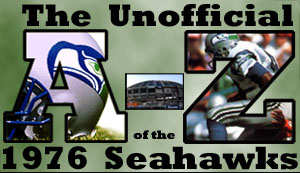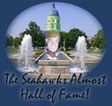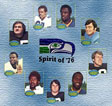
No longer a child, not yet middle-aged, and still finding their place in the NFL world.
...the 30-year wall of silence is an impressive achievement for a League that leaks as a lifestyle.
He recommended Jack Patera enthusiastically for the Seahawks...
The letter C is coming soon!
The Seahawks used Williams’ local reputation as a promotional tool, as they would do (very briefly) with Ahmad Rashad.
The average Seahawk selected in the veteran allocation is 6-2, 222 pounds, just under 26 years old and is entering his fourth NFL season.
The Seahawks played the Rams...facing off against future Seahawk coaches Chuck Knox, Tom Catlin and Ken Meyer.
...management decided early to pursue coaches with no NFL head coaching experience.
Patera had the boldness to recruit 3 coaches with no NFL service...
...why was there no place for one of the ultimate local heroes of the early 1970s – Sonny Sixkiller?
Thompson may have looked on paper like a conservative and safe manager for a new team with first-time owners, but...
...reports from the camp are unclear as to who did the special team evaluations.
As a defensive coach, Jack Patera valued his linebackers.
Maybe we'll come up with something soon!
...nobody else on the Seahawks squad took their dislike quite to the extent of Ahmad Rashad.
The Nordstroms were an obvious possibility because of their wealth and local presence.
Approximately 14 members of that squad would never play for the Seahawks again.
A simple lesson in draft history is to list the fate of quarterbacks for several years before 1976.
Jack Patera was unable to take a single Redskin veteran from the allocation list.
...the Seahawks’ offense would be directed by 3 men who had 2 years of NFL experience between them
Terry Brown’s Seahawk career lasted less than 24 hours.
...we think this story might just have been a good Patera Prank!
While Patera had an inside edge on stocking his team with Vikings, he only chose one Viking from the allocation...
Character would clearly play a part...
Patera lived up to his code of we will tolerate you until we can replace you...
Yes! We will have something for Y eventually!
What more need we say?
|
Intro |
A |
B |
C |
D |
E |
F |
G |
H |
I |
J |
K |
L |
M |
N |
O |
P |
Q |
R |
S |
T |
U |
V |
W |
X |
Y |
Z |
Home

A is for Allocation
The NFL’s rules for allocating veteran players to the Seahawks and the Buccaneers were substantially the same as for the 1960s expansions. No existing team was to have its roster raided disproportionately; the expansion teams would not be allowed to take players from an existing team except by allocation; and the allocation would be held just before the start of the 1976 pre-season training.
The Seahawks had been denied a recruiting opportunity in September 1975 when the World Football League collapsed. Like a number of struggling teams, the Seahawks would have hoped for a bonanza from the defunct competitor: but the NFL stepped in and ruled that all WFL players who had been under contract to an NFL club when they changed leagues were controlled by their NFL club. The policy of protecting existing teams as far as reasonably possible (and maybe more) would stay in place. The most significant details were:
As far as we’re aware, the NFL and the teams have never published the list of unprotected players. Nor have they identified the order in which the veterans were selected.
The list was clearly a secret in 1976, based on the number of players who were surprised that they had been left unprotected in the allocation. Neil Graff was on his honeymoon, unaware that he was on the Patriots’ list; Bob Penchion was upset at being left unprotected by the 49ers just as his career was breaking through; Bill Olds clearly wanted to stay in Baltimore; and other players were quoted in similar terms. Holding the allocation while players weren’t in camp helped to keep the names quiet, which was sensible politics. Secrecy served the existing teams by avoiding a public announcement that certain players were not among the 32 most valuable players on the roster. With a maximum of 6 players able to be selected, a number of players would have known their (lower) place in the team, but wouldn’t have been allocated: so keeping the names quiet spared embarrassment and unpleasant consequences. Even so, the 30-year wall of silence is an impressive achievement for a League that leaks as a lifestyle. The Seahawks might have been forgiven for thinking that the allocation was a poor return for a $16 million franchise fee. The allocation rules required the team to conduct an enormous amount of speculative research on possible unprotected players, only a couple of months (or less) after Jack Patera and his staff had been appointed. While Patera could be sure that many star players would be protected, and didn’t need to be scouted, he would have been realistic to read up on at least 200 players from the 1975 rosters — at the same time as getting to know his new staff and working out the kind of game they would be playing and the kind of players they’d want from that hypothetical list. As well, the prohibition on approaching individual players outside the allocation would have been a serious problem. Patera was denied the opportunity to negotiate with “franchise” players best suited to his style — particularly those who may have been playing out their option year before becoming the 1970s version of free agents. One of the obvious consequences of the allocation rules was the inability to target a quality veteran quarterback. The Seahawks would take months to solve the problem, with the solution turning out to be one of the great stories of the team. The Buccaneers never solved the problem at all.
|
 Each expansion team would be allowed to select a maximum of 39 veterans.
Each expansion team would be allowed to select a maximum of 39 veterans.
